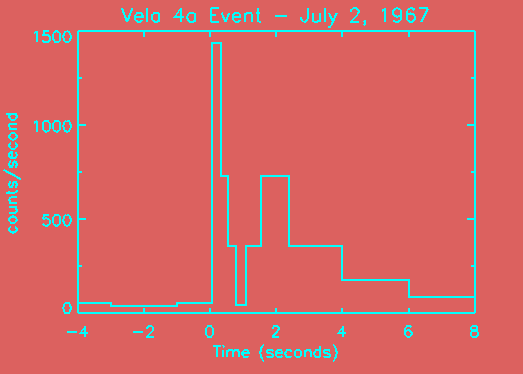 |
Астронет: Астрономическая картинка дня Гамма-всплеск: взрыв с указателем расстояния http://variable-stars.ru/db/msg/1163675/eng |
Credit & Copyright: R. Klebesadel, I. Strong & R. Olson
(LANL),
Vela Satellite Team
Explanation:
Gamma-Ray Bursts (GRBs)
were discovered by accident.
In fact,
GRBs always seem to be
where scientists least expect them.
Thirty years ago today, satellites
first recorded a GRB.
The burst data plotted in this
histogram show that
the count rate of the gamma-ray instrument
abruptly jumped indicating a sudden flash of gamma-rays.
The Vela satellites
that detected this and other GRBs were
developed to test technology to monitor
nuclear test ban treaties.
With on board sensors they watched for brief
X-ray and gamma-ray
flashes, the telltale signs of
nuclear explosions from the vicinity of
the Earth.
As intended, the Velas
found flashes of gamma-rays - but not
from nuclear detonations near Earth.
Instead, the flashes came from deep space!
Dubbed
"cosmic gamma-ray bursts"
their origin was then unknown and is still
controversial.
However, the gamma-ray surprises were not over.
Exploring the high-energy sky
nearly 25 years later, the orbiting Compton Observatory's
Burst and Transient Source Experiment (BATSE), intentionally
designed to detect cosmic gamma-ray bursts,
was searching for clues to the GRB mystery.
But the second burst BATSE recorded
did not come from deep space. It came from near the Earth!
Don't worry,
these terrestrial GRBs are not nuclear bombs exploding.
They are
a new phenomenon now thought to be related to a
recently discovered type of
high altitude lightning.
Exploring new horizons continues to yield
unexpected results.
Authors & editors:
Robert Nemiroff
(MTU) &
Jerry Bonnell
(USRA)
NASA Web Site Statements, Warnings,
and Disclaimers
NASA Official: Jay Norris.
Specific
rights apply.
A service of:
LHEA at
NASA /
GSFC
& Michigan Tech. U.
